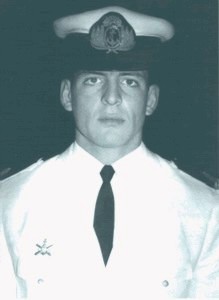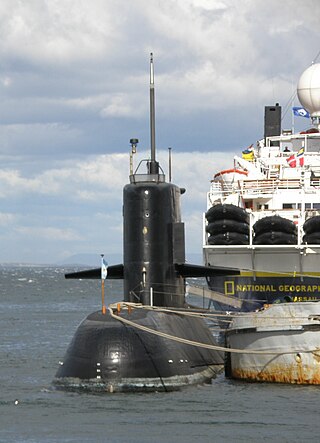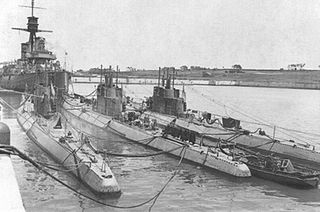
The Argentine Navy is the navy of Argentina. It is one of the three branches of the Armed Forces of the Argentine Republic, together with the Army and the Air Force.
This article describes the composition and actions of the Argentine naval forces in the Falklands War. For a list of naval forces from the United Kingdom, see British naval forces in the Falklands War.

ARA Santa Fe was an Argentine Balao-class submarine that was lost during the Falklands War. Built by the US during the Second World War, the ship operated in the United States Navy as USS Catfish (SS-339) until 1971 when she was transferred to the Argentine Navy. She served until 1982 when she was captured by the British at South Georgia after being seriously damaged and subsequently sank along a pier, with just her conning tower (sail) visible above the waterline. The submarine was raised, towed out of the bay and scuttled in deep water in 1985.

ARA San Luis (S-32) was a Type 209 diesel-powered submarine of the Argentine Navy. Built in Germany, San Luis has a displacement of 1,285 tonnes and was commissioned in 1974. The submarine operated against the Royal Navy during the Falklands War without any noticeable success, but survived a number of anti-submarine sweeps carried out by British frigates. San Luis was struck in 1997 after an incomplete overhaul; as of 2020, its hull remained stored at Domecq Garcia Shipyard (Tandanor).

The Viceroyalty of the Río de la Plata meaning "River of the Silver", also called "Viceroyalty of the River Plate" in some scholarly writings, in southern South America, was the last to be organized and also the shortest-lived of the Viceroyalties of the Spanish Empire in the Americas. The name "Provincias del Río de la Plata" was formally adopted in 1810 during the Cortes of Cádiz to designate the Viceroyalty of the Río de la Plata.

USS Chivo (SS-341), a Balao-class submarine, was a ship of the United States Navy named for the "chivo" or big-scaled goatfish Pseudopenaeus grandisquamis, a fish inhabiting the Pacific Ocean between Panama and Mexico.

USS Lamprey (SS-372), a Balao-class submarine, was a ship of the United States Navy named for the lamprey, any of certain eel-like aquatic vertebrates.

USS Macabi (SS-375) was a Balao-class submarine of the United States Navy, named for the macabi, a bonefish living in tropical seas and off the American coasts as far north as San Diego and Long Island and reaching a length of 3 feet (1 m).
Departments form the second level of administrative division, and are subdivided in municipalities. They are extended in all of Argentina except for the Province of Buenos Aires and the Autonomous City of Buenos Aires, the national capital, each of which has different administrative arrangements.

The following is an alphabetical list of topics related to the Argentina.

Capitan de Corbeta Pedro Edgardo Giachino, was an Argentine Navy officer who became the first serviceman killed in action during the Falklands War.

The TR-1700 is a class of diesel-electric patrol submarines built by Thyssen Nordseewerke for the Argentine Navy in the 1980s, with two submarines completed. These ships are amongst the largest submarines built in Germany since World War II and are among the fastest diesel-electric submarines in the world. ARA San Juan was lost on 17 November 2017, leaving ARA Santa Cruz as the only remaining submarine of this class. As of 2020, the refit of Santa Cruz has been reported cancelled leaving the entire class inactive.

ARA Santa Cruz (S-41) is a member of the TR-1700 class of diesel-electric submarines of the Argentine Navy.

ARA San Juan (S-42) was a TR-1700-class diesel-electric submarine in service with the Submarine Force of the Argentine Navy from 1985 to 2017. It was built in West Germany, entering service on 19 November 1985, and underwent a mid-life update from 2008 to 2013.

ARA Salta (S-31) is a Type 209 diesel-electric attack submarine in service with the Argentine Navy. The vessel was reported as incapable of navigation as of 2020. However, Argentine navy divers were reported to be using her as a training platform at dockside.

The Santa Fe-class submarines, also known as the Tarantinos after the city in which they were built, were a class of three pre-World War II submarines, designed and built in Italy in 1928-1933, as part of an Argentine expansion plan for its navy. They were in service with the Argentine Navy from the early 1930s to the late 1950s. The class was named after Argentine provinces starting with “S”, as traditional in the Argentine Navy.
On 15 November 2017, the Argentine submarine ARA San Juan disappeared off the coast of Argentina while on a training exercise. After a search lasting 15 days, the Argentine Navy downgraded the operation from a rescue mission to a search for the submarine's wreck, implying they had given up any hope of finding survivors among its crew of 44. It was the worst submarine disaster since the accident on Chinese submarine 361 in 2003, and the second worst peacetime naval disaster in Argentina after the 1949 sinking of the minesweeper ARA Fournier.

Eliana María Krawczyk was an officer of the Argentine Navy. She was among the 44 crew members of the Argentine submarine ARA San Juan when it sank on 15 November 2017.




















